fire department
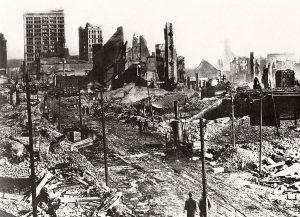 As disastrous fires go, the Great Baltimore Fire comes in historically as the third worst conflagration in an American city, surpassed only by the Great Chicago Fire of 1871, and the San Francisco Earthquake and Fire of 1906. There were other major urban disasters that were comparable in cost, but not fires. These were the Galveston Hurricane of 1900 and most recently, Hurricane Katrina that hit New Orleans and the Gulf of Mexico coast in August 2005.
As disastrous fires go, the Great Baltimore Fire comes in historically as the third worst conflagration in an American city, surpassed only by the Great Chicago Fire of 1871, and the San Francisco Earthquake and Fire of 1906. There were other major urban disasters that were comparable in cost, but not fires. These were the Galveston Hurricane of 1900 and most recently, Hurricane Katrina that hit New Orleans and the Gulf of Mexico coast in August 2005.
On February 7, 1904, a small fire was reported at the John Hurst and Company building on West German Street at Hopkins Place, The site is currently the Royal Farms Arena in the western part of downtown Baltimore. The fire started at about 10:48am, and quickly spread. It wasn’t long before the fire surpassed the ability of the city’s firefighting resources, and calls for help were telegraphed to other cities. By 1:30pm, units from Washington, DC were arriving on the Baltimore and Ohio Railroad at Camden Street Station. Officials decided to use a firebreak in an effort to halt the fires progression. They dynamited buildings around the existing fire. Unfortunately, this tactic was unsuccessful. The fire continued to rage and spread until it was finally brought under control about 5:00pm on February 8, 1904.
In the end, the fire engulfed a large portion of the city that evening. The culprit for starting the fire is believed to have been a discarded cigarette in the basement of the Hurst Building. When the fire was finally out after burning for 31 hours, an 80-block area of downtown Baltimore, stretching from the waterfront to Mount Vernon on Charles Street, had been destroyed. More than 1,500 buildings were completely leveled, and some 1,000 severely damaged, bringing property loss from the disaster to an estimated $100 million. No lives were lose in this disaster…miraculously, although some reports did claim one man died, but that was not confirmed. The fire raged from North Howard Street in the west and southwest, the flames spread north through the retail shopping area as far as Fayette Street and began moving eastward, pushed along by the prevailing winds. Amazingly, it narrowly missed the new 1900 Circuit Courthouse…now known as the Clarence M. Mitchell, Jr. Courthouse. The fire passed the historic Battle Monument Square from 1815 to 1827 at North Calvert Street, and the quarter-century-old  Baltimore City Hall of 1875 on Holliday Street; and finally spread further east to the Jones Falls stream which divided the downtown business district from the old East Baltimore tightly-packed residential neighborhoods of Jonestown…also known as Old Town and newly named Little Italy.” The fire burned as far south as the wharves and piers lining the north side of the old “Basin,” now the “Inner Harbor” of the Northwest Branch of the Baltimore Harbor and Patapsco River facing along Pratt Street. Also spared was Baltimore’s domed City Hall, built in 1867. The Great Baltimore Fire was the most destructive fire in the United States since the Great Chicago Fire of 1871, It destroyed most of the city and caused an estimated $200 million in property damage.
Baltimore City Hall of 1875 on Holliday Street; and finally spread further east to the Jones Falls stream which divided the downtown business district from the old East Baltimore tightly-packed residential neighborhoods of Jonestown…also known as Old Town and newly named Little Italy.” The fire burned as far south as the wharves and piers lining the north side of the old “Basin,” now the “Inner Harbor” of the Northwest Branch of the Baltimore Harbor and Patapsco River facing along Pratt Street. Also spared was Baltimore’s domed City Hall, built in 1867. The Great Baltimore Fire was the most destructive fire in the United States since the Great Chicago Fire of 1871, It destroyed most of the city and caused an estimated $200 million in property damage.
 It was a typical day in Texas City, Texas…a port city in Galveston Bay. April was always warm, in the mid-70s, so it was perfect outdoor weather. Fires around the docks were a fairly common occurrence in Texas City, and it was not unusual for residents to travel down to the docks to watch the fires and the firemen working. Fires tend to attract the casual observer as well as the local news agencies. This day started out just as any other typical Texas day, but all that would change very soon. On the morning of April 16, 1947 a fire broke out on the S.S. Grandcamp. The fire produced a dense, brilliantly colored smoke that could be seen all over town. On board Grandcamp, among other things, was a supply of ammonium nitrate, which was producing the brilliant colors. The ship was docked in the Texas City port, so the smoke could be seen all over town. This fire, like any other, brought anybody who had any free time down to the dock to watch the action. This would be a fatal mistake for many of the bystanders.
It was a typical day in Texas City, Texas…a port city in Galveston Bay. April was always warm, in the mid-70s, so it was perfect outdoor weather. Fires around the docks were a fairly common occurrence in Texas City, and it was not unusual for residents to travel down to the docks to watch the fires and the firemen working. Fires tend to attract the casual observer as well as the local news agencies. This day started out just as any other typical Texas day, but all that would change very soon. On the morning of April 16, 1947 a fire broke out on the S.S. Grandcamp. The fire produced a dense, brilliantly colored smoke that could be seen all over town. On board Grandcamp, among other things, was a supply of ammonium nitrate, which was producing the brilliant colors. The ship was docked in the Texas City port, so the smoke could be seen all over town. This fire, like any other, brought anybody who had any free time down to the dock to watch the action. This would be a fatal mistake for many of the bystanders.
The ammonium nitrate on board the Grandcamp detonated at 9:12 am, blowing he ship apart and sending the cargo of peanuts, tobacco, twine, bunker oil and the remaining bags of ammonium nitrate 2,000 to 3,000 feet into the air. Fireballs streaked across the sky and could be seen for miles across Galveston Bay as molten ship fragments erupted out of the pier. The blast sent a fifteen foot tidal wave crashing onto the dock and flooding the surrounding area. Windows were shattered in Houston, 40 miles to the north, and people in Louisiana felt the shock 250 miles away. Most of the buildings closest to the blast were flattened, and there were many more that had doors and roofs blown off. The Monsanto plant which was only three hundred feet away, was destroyed by the blast. Most of the Texas City Terminal Railways’ warehouses along the docks were destroyed. Hundreds of employees, pedestrians and bystanders were killed. At the time of the Grandcamp’s explosion, only two additional vessels were docked in port…the S.S. High Flyer and the Wilson B. Keene, both American C-2 cargo ships similar to the Grandcamp.
The intensity of the blast sent shrapnel tearing into the surrounding area. Flaming debris ignited giant tanks full 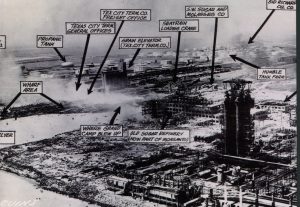 of oil and chemicals stored at the refineries, causing a set of secondary fires and smaller explosions. The Longhorn II, a barge anchored in port, was lifted out of the water by the sheer force of the explosion and landed 100 feet away on the shore. Buildings blazed long after the initial explosion, provoking large scale emergency relief efforts throughout the day, that night, and into the following day. The fires in nearby industrial buildings and chemical plants spread the destruction even farther. The chief and 27 firefighters from the Texas City Fire Department were killed in the initial blast. Official estimates put the death toll at 567 and injuries at more than 5,000. Some of the dead were never identified, and some may never have been found at all.
of oil and chemicals stored at the refineries, causing a set of secondary fires and smaller explosions. The Longhorn II, a barge anchored in port, was lifted out of the water by the sheer force of the explosion and landed 100 feet away on the shore. Buildings blazed long after the initial explosion, provoking large scale emergency relief efforts throughout the day, that night, and into the following day. The fires in nearby industrial buildings and chemical plants spread the destruction even farther. The chief and 27 firefighters from the Texas City Fire Department were killed in the initial blast. Official estimates put the death toll at 567 and injuries at more than 5,000. Some of the dead were never identified, and some may never have been found at all.
The blast registered on a seismograph as far away as Denver, Colorado. Dockworker Pete Suderman remembers flying thirty feet as the blast carried him and several of the dock’s three-inch wooden planks across the pier. Nattie Morrow was in her home with her two children and sister-in-law Sadie. She watched the billowing smoke near the Monsanto plant from her back porch just prior to the blast. “Suddenly a thundering boom sounded, and seconds later the door ripped off its facing, skidded across the kitchen floor, and slammed down onto the table where I sat with the baby. The house toppled to one side and sat off its piers at a crazy angle. Broken glass filled the air, and we didn’t know what was happening.”
At the time of the explosion, phone services in Texas City were not working because of a telephone operators’ strike. When the operators learned of the accident, they quickly went back to work, but the strike caused an initial delay in coordinating rescue efforts. Once operators began calling for help, rescue workers from all over the area began responding immediately. The U.S. Army, Navy, Coast Guard, Marine Reserve and the Texas National Guard all sent personnel, including doctors, nurses and ambulances. The University of Texas Medical Branch at Galveston sent doctors, nurses, and medical students. Firefighters from Galveston, Houston, Fort Crockett, Ellington Field, and surrounding towns arrived to help. The cities of Galveston, Houston and San Antonio sent policemen to assist the Texas City Police Department in maintaining order after the explosion. The U.S. Army flew in blood  plasma, gas masks, food, and other supplies, provided bull-dozers to begin clearing the wreckage, and set up temporary housing for the survivors at Camp Wallace in Hitchcock. The Red Cross, Salvation Army and the Boy and Girl Scouts of America sent a flood of volunteers who provided first aid, food, water and comfort to city residents. Volunteers from other local organizations, and others who were not part of any organization, felt compelled to help. There was no operational hospital in Texas City at the time of the disaster, so volunteers converted city hall and chamber of commerce buildings into makeshift infirmaries. Many wounded were evacuated to John Sealy Hospital in Galveston, the hospital at Fort Crockett, and hospitals in Houston.
plasma, gas masks, food, and other supplies, provided bull-dozers to begin clearing the wreckage, and set up temporary housing for the survivors at Camp Wallace in Hitchcock. The Red Cross, Salvation Army and the Boy and Girl Scouts of America sent a flood of volunteers who provided first aid, food, water and comfort to city residents. Volunteers from other local organizations, and others who were not part of any organization, felt compelled to help. There was no operational hospital in Texas City at the time of the disaster, so volunteers converted city hall and chamber of commerce buildings into makeshift infirmaries. Many wounded were evacuated to John Sealy Hospital in Galveston, the hospital at Fort Crockett, and hospitals in Houston.

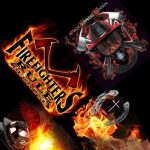 I realize that everyone who has a goal in mind for their life, must be focused on that goal, in order to achieve it, but I find that very few people say that they want to do a certain thing when they are in high school, and then follow through to achieve that goal. My grandson, Josh Petersen is such a focused young man. He wants to be a firefighter and EMT, and he just keeps taking the steps that he knows are necessary to get there. He completed some of the Fire Science classes in high school, using the Boces program, and now that he is in college, he just keeps moving forward toward his goal. I am very proud of his accomplishments thus far, and I look forward to all the great things he is going to do in the future. During the Boces classes, one of the instructors took Josh under his wing, and continues to mentor him as he moves forward. I don’t think his instructor had ever had a high school student the Fire Science class. The mentoring has really helped Josh, because he has been advised on which classes to take in order to better proceed through his requirements.
I realize that everyone who has a goal in mind for their life, must be focused on that goal, in order to achieve it, but I find that very few people say that they want to do a certain thing when they are in high school, and then follow through to achieve that goal. My grandson, Josh Petersen is such a focused young man. He wants to be a firefighter and EMT, and he just keeps taking the steps that he knows are necessary to get there. He completed some of the Fire Science classes in high school, using the Boces program, and now that he is in college, he just keeps moving forward toward his goal. I am very proud of his accomplishments thus far, and I look forward to all the great things he is going to do in the future. During the Boces classes, one of the instructors took Josh under his wing, and continues to mentor him as he moves forward. I don’t think his instructor had ever had a high school student the Fire Science class. The mentoring has really helped Josh, because he has been advised on which classes to take in order to better proceed through his requirements.
One of the most recent classes that Josh is taking is one that I am very excited about. He is in the current EMT course that is offered through the Bar Nunn, Wyoming fire department. I’m having a difficult time wrapping my head around the fact that when this class is over, my grandson will be ready for state licensing tests to become an EMT…and he will only be 19 years old. That makes me very proud. Josh is enjoying the classes, but really looks forward to the clinical part of the training, when he actually works with patients. That makes sense. Every EMT, nurse, CNA, or other health care professional wants to move beyond the learning stages and get to doing the work. When I asked Josh about his class, he told me that it was interesting, but he was looking forward to the clinical training. He is always keeping his eyes on the prize, and that makes me very proud.
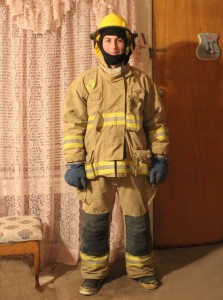
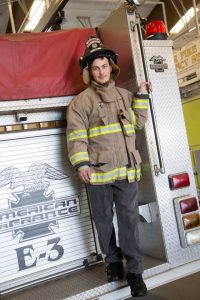
Of course, Josh is still very focused on his training to be a firefighter too. He loves everything firefighter. He loves t-shirts and tattoos that have anything to do with firefighting or EMT work. Everything he does these days is to further himself toward the ultimate goal. That takes determination and drive. He loves volunteer work too, especially if it is sponsored by the fire department. I’m sure that every time he sees anything about a fire, he wishes he could be there to help with the efforts to put the fire out. I know that with Josh’s focus and determination, he will become an amazing firefighter and EMT. We are so proud of him. Today is Josh’s 19th birthday. Happy birthday Josh!! Have a great day!! We love you!!

